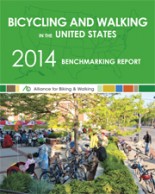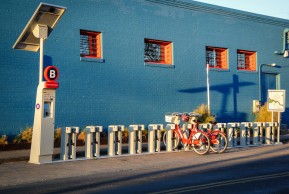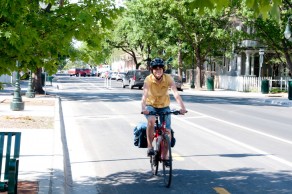 According to the Alliance for Biking & Walking, bike share programs across the country are surging. Earlier this year, the alliance published its biennial Bicycling and Walking in the United States, 2014 Benchmaking Report, which collects and analyzes data on bicycling and walking demographics, safety, funding, policies, infrastructure, education, public health indicators, and economic impacts in all 50 states, the country’s 52 largest cities, and several midsize cities. The 2014 report shows that biking—and walking—is on the rise, and both activities are gradually becoming safer.
According to the Alliance for Biking & Walking, bike share programs across the country are surging. Earlier this year, the alliance published its biennial Bicycling and Walking in the United States, 2014 Benchmaking Report, which collects and analyzes data on bicycling and walking demographics, safety, funding, policies, infrastructure, education, public health indicators, and economic impacts in all 50 states, the country’s 52 largest cities, and several midsize cities. The 2014 report shows that biking—and walking—is on the rise, and both activities are gradually becoming safer.
This is true perhaps no more so than in Austin, Texas. The city council adopted a new Bicycle Master Plan on November 6, which aims to significantly increase bicycle use and improve bicycle safety throughout Austin by creating a connected and protected transportation network that will offer additional transportation options for Austin residents and visitors.
Austin B-cycle’s first 11 bike share stations opened in December 2014. The full 40-station system was operational in March, immediately setting a nationwide record during the city’s South By Southwest music festival. The 10-day event held March 7–16 saw an average of 6.4 checkouts per bike per day. On Friday, March 14, that number jumped to 2,774 checkouts, an average of 10.1 checkouts per bike for the day, beating the previous record held by New York City’s Citi Bike program. The total number of checkouts during SXSW reached 17,000.

“It’s clear that SXSW attendees love Austin B-cycle,” said Executive Director Elliott McFadden, in a statement on the group’s website. “Not only are we thrilled by how attendees embraced our system, we are impressed by how well the B-cycle bikes, stations, and software held up to the high usage.” The system was available for use 24 hours per day.
The report also showed that more people tend to bike or walk in a city that has strong biking and walking advocacy, and shows that the number of grassroots groups working on the issue have grown dramatically. Bike Austin is a nonprofit organization that aims to bring more people to bicycling through advocacy, outreach, and education. The top priority listed in the group’s strategic plan is to make biking in Austin safer and more accessible, which it plans to accomplish through advocating for a world-class network of bikeways throughout the metro area and ensuring that bicyclists are protected under the law. The group also works on a local level to grow the bicycle movement by organizing community bicycling events.
In 2012, the city adopted Imagine Austin, a 30-year comprehensive plan that aims to create a vibrant, more livable city. Eight priority programs detail Imagine Austin’s goals, including revising Austin’s land development regulations and processes to promote a compact and connected city.

Austin established the CodeNEXT project to rewrite its outdated land development code. The city says that the revised LDC should promote development that makes walking, biking, and public transportation more accessible and reinforces compact development that facilitates a range of transportation choices, including biking.
Opticos Design has been working with the City of Austin on the CodeNEXT process. In its recently released diagnosis of the city’s current LDC, Opticos said that planning efforts to establish new transit-oriented districts have better integrated land use and transportation planning by linking higher density development, appropriate regulations, and current or future transit and transportation investments. By improving the coordination of these disciplines, an environment that better accommodates transit, vehicles, pedestrians, and bikes can emerge.
Featured image courtesy of Austin B-Cycle. Article originally posted May 29, 2014. Updated November 10, 2014.
Like this article? How about these:
- Does the Cost of Your Commute Make Your Housing More or Less Affordable?
- Parking Guru Donald Shoup: The Pseudo-Science of Parking Regulations
- Karen Parolek: Why I Bike